
Brick Renaissance
Encyclopedia
Brick Renaissance is the Northern Europe
an continuation of brick
architecture after Brick Romanesque
and Brick Gothic
. Although the term Brick Gothic is often used generally for all of this architecture, especially in regard to the Hanseatic
cities of the Baltic
, the stylistic changes that led to the end of Gothic architecture
did reach Northern Germany
and northern Europe with delay, leading to the adoption of Renaissance
elements into brick building. Nonetheless, it is very difficult for non-experts to distinguish transitional phases or early Brick Renaissance, as the style maintained many typical features of Brick Gothic, such as stepped gables
. A clearer distinction only developed at the transition to Baroque architecture
. In Lübeck
, for example, Brick Renaissance is clearly recognisable in buildings equipped with terracotta reliefs by the artist Statius von Düren, who was also active at Schwerin
(Schwerin Castle
) and Wismar
(Fürstenhof).
More clearly recognisable as Renaissance are brick buildings strongly influenced by the Dutch Renaissance style, such as Reinbek Castle at Reinbek
near Hamburg
, the Zeughaus at Lübeck, or Friedrichstadt
in Schleswig-Holstein
.
Northern Europe
Northern Europe is the northern part or region of Europe. Northern Europe typically refers to the seven countries in the northern part of the European subcontinent which includes Denmark, Estonia, Latvia, Lithuania, Norway, Finland and Sweden...
an continuation of brick
Brick
A brick is a block of ceramic material used in masonry construction, usually laid using various kinds of mortar. It has been regarded as one of the longest lasting and strongest building materials used throughout history.-History:...
architecture after Brick Romanesque
Brick Romanesque
Brick Romanesque is an architectural style and chronological phase of architectural history. The term described Romanesque buildings built of brick; like the subsequent Brick Gothic, it is geographically limited to Northern Germany and the Baltic region...
and Brick Gothic
Brick Gothic
Brick Gothic is a specific style of Gothic architecture common in Northern Europe, especially in Northern Germany and the regions around the Baltic Sea that do not have natural rock resources. The buildings are essentially built from bricks...
. Although the term Brick Gothic is often used generally for all of this architecture, especially in regard to the Hanseatic
Hanseatic League
The Hanseatic League was an economic alliance of trading cities and their merchant guilds that dominated trade along the coast of Northern Europe...
cities of the Baltic
Baltic region
The terms Baltic region, Baltic Rim countries, and Baltic Rim refer to slightly different combinations of countries in the general area surrounding the Baltic Sea.- Etymology :...
, the stylistic changes that led to the end of Gothic architecture
Gothic architecture
Gothic architecture is a style of architecture that flourished during the high and late medieval period. It evolved from Romanesque architecture and was succeeded by Renaissance architecture....
did reach Northern Germany
Northern Germany
- Geography :The key terrain features of North Germany are the marshes along the coastline of the North Sea and Baltic Sea, and the geest and heaths inland. Also prominent are the low hills of the Baltic Uplands, the ground moraines, end moraines, sandur, glacial valleys, bogs, and Luch...
and northern Europe with delay, leading to the adoption of Renaissance
Renaissance architecture
Renaissance architecture is the architecture of the period between the early 15th and early 17th centuries in different regions of Europe, demonstrating a conscious revival and development of certain elements of ancient Greek and Roman thought and material culture. Stylistically, Renaissance...
elements into brick building. Nonetheless, it is very difficult for non-experts to distinguish transitional phases or early Brick Renaissance, as the style maintained many typical features of Brick Gothic, such as stepped gables
Crow-stepped gable
A Stepped gable, Crow-stepped gable, or Corbie step is a stair-step type of design at the top of the triangular gable-end of a building...
. A clearer distinction only developed at the transition to Baroque architecture
Baroque architecture
Baroque architecture is a term used to describe the building style of the Baroque era, begun in late sixteenth century Italy, that took the Roman vocabulary of Renaissance architecture and used it in a new rhetorical and theatrical fashion, often to express the triumph of the Catholic Church and...
. In Lübeck
Lübeck
The Hanseatic City of Lübeck is the second-largest city in Schleswig-Holstein, in northern Germany, and one of the major ports of Germany. It was for several centuries the "capital" of the Hanseatic League and, because of its Brick Gothic architectural heritage, is listed by UNESCO as a World...
, for example, Brick Renaissance is clearly recognisable in buildings equipped with terracotta reliefs by the artist Statius von Düren, who was also active at Schwerin
Schwerin
Schwerin is the capital and second-largest city of the northern German state of Mecklenburg-Vorpommern. The population, as of end of 2009, was 95,041.-History:...
(Schwerin Castle
Schwerin Castle
Schwerin Castle is a castle located in the city of Schwerin, the capital of the Bundesland of Mecklenburg-Vorpommern, Germany. For centuries it was the home of the dukes and grand dukes of Mecklenburg and later Mecklenburg-Schwerin. It currently serves as the seat of the state...
) and Wismar
Wismar
Wismar , is a small port and Hanseatic League town in northern Germany on the Baltic Sea, in the state of Mecklenburg-Vorpommern,about 45 km due east of Lübeck, and 30 km due north of Schwerin. Its natural harbour, located in the Bay of Wismar is well-protected by a promontory. The...
(Fürstenhof).
More clearly recognisable as Renaissance are brick buildings strongly influenced by the Dutch Renaissance style, such as Reinbek Castle at Reinbek
Reinbek
Reinbek is a town located in Stormarn district in the northern German state of Schleswig-Holstein within the metropolitan region of Hamburg...
near Hamburg
Hamburg
-History:The first historic name for the city was, according to Claudius Ptolemy's reports, Treva.But the city takes its modern name, Hamburg, from the first permanent building on the site, a castle whose construction was ordered by the Emperor Charlemagne in AD 808...
, the Zeughaus at Lübeck, or Friedrichstadt
Friedrichstadt
Friedrichstadt is a town in the district of Nordfriesland, in Schleswig-Holstein, Germany. It is situated on the river Eider approx. 12 km south of Husum. It was founded in 1621 by Dutch settlers...
in Schleswig-Holstein
Schleswig-Holstein
Schleswig-Holstein is the northernmost of the sixteen states of Germany, comprising most of the historical duchy of Holstein and the southern part of the former Duchy of Schleswig...
.
Belarus
| Place | Building | Main period of construction | Special features | Image |
| Mir Mir, Belarus Mir is an urban settlement in Kareličy raion, Hrodna Voblast, Belarus on the banks of Miranka River, about 85 kilometers southwest of the national capital, Minsk.... |
Mir Castle Mir Castle Complex The Mirsky Castle Complex , is a UNESCO World Heritage site in Belarus located in the town of Mir in the Karelichy District of the Hrodna voblast, at , 29 km to the north-west from another World Heritage site, Nesvizh Castle.... |
15th-16th century | Late 16th century additions to Gothic structure | |
Denmark
| Place | Building | Main period of construction | Special features | Image |
| Copenhagen Copenhagen Copenhagen is the capital and largest city of Denmark, with an urban population of 1,199,224 and a metropolitan population of 1,930,260 . With the completion of the transnational Øresund Bridge in 2000, Copenhagen has become the centre of the increasingly integrating Øresund Region... |
Børsen Børsen Børsen is a building on Slotsholmen in central Copenhagen, Denmark. It is built by Christian IV in 1619–1640 and is the oldest stock exchange in Denmark... |
1619–1640 | Dutch Renaissance style (architects Hans and Lorents van Steenwinckel) renaissance | 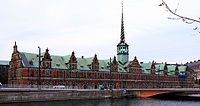 |
| Rosenborg Castle Rosenborg Castle Rosenborg Castle is a renaissance castle located in the centre of Copenhagen, Denmark. The castle was originally built as a country summerhouse in 1606 and is an example of Christian IV's many architectural projects... |
1606–1624 | Built in the Dutch Renaissance style by Architects Bertel Lange and Hans van Steenwinckel | ||
| Hillerød Hillerød Hillerød Kommune is a municipality in Region Hovedstaden . The municipality covers an area of 191 km² , and has a total population of 46,568... |
Frederiksborg Palace Frederiksborg Palace Frederiksborg castle is a castle in Hillerød, Denmark. It was built as a royal residence for King Christian IV, and is now known as The Museum of National History. The current building replaced a previous castle erected by Frederick II, and is the largest Renaissance palace in Scandinavia... |
1602–1620 | Dutch Renaissance style (architects Hans and Lorents van Steenwinckel) | |
Germany
| Place | Building | Main period of construction | Special features | Image |
| Friedrichstadt Friedrichstadt Friedrichstadt is a town in the district of Nordfriesland, in Schleswig-Holstein, Germany. It is situated on the river Eider approx. 12 km south of Husum. It was founded in 1621 by Dutch settlers... |
Market Square | early 17th century | Plastered brick | 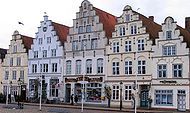 |
| Lübeck Lübeck The Hanseatic City of Lübeck is the second-largest city in Schleswig-Holstein, in northern Germany, and one of the major ports of Germany. It was for several centuries the "capital" of the Hanseatic League and, because of its Brick Gothic architectural heritage, is listed by UNESCO as a World... |
Mühlentor | 1550s (model) | ||
| Schiffergesellschaft | 1535–1538 | |||
| Zeughaus | 1594 | |||
| Reinbek Reinbek Reinbek is a town located in Stormarn district in the northern German state of Schleswig-Holstein within the metropolitan region of Hamburg... |
Castle | 1572–1576 | ||
Italy
| Place | Building | Main period of construction | Special features | Image |
| Ferrara Ferrara Ferrara is a city and comune in Emilia-Romagna, northern Italy, capital city of the Province of Ferrara. It is situated 50 km north-northeast of Bologna, on the Po di Volano, a branch channel of the main stream of the Po River, located 5 km north... |
Castello Estense Castello Estense The Castle Estense or Castle of Saint Michele is a moated medieval structure in the center of Ferrara, northern Italy. It is a large block with four corner towers.- History :... |
1385–1450, early 16th century | The castle essentially presents the appearance given to it by Girolamo da Carpi in the second half of the 16th century |  |
| Milan Milan Milan is the second-largest city in Italy and the capital city of the region of Lombardy and of the province of Milan. The city proper has a population of about 1.3 million, while its urban area, roughly coinciding with its administrative province and the bordering Province of Monza and Brianza ,... |
Castello Sforzesco Castello Sforzesco Castello Sforzesco is a castle in Milan, Italy, that used to be the seat and residence of the Duchy of Milan and one of the biggest citadels in Europe and now houses several of the city's museums and art collections.-History:... |
14th century, 1450 | 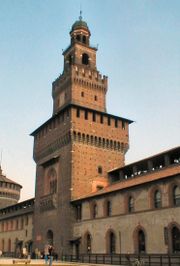 |
|
Lithuania
| Town/city | Building | Main period of construction | Special features | Image |
| Vytėnai | Panemunė Castle Panemune Castle Panemunė Castle is a castle on the right bank of the Nemunas river, in Vytėnai, Jurbarkas district, Lithuania.The initial hillfort of the Teutonic Knights was replaced by a castle built in 1604-1610 and reconstructed around 1759 by Giełgud family. Remaining wings of the castle have been recently... |
1604–1610 | ||
| Raudondvaris Raudondvaris Raudondvaris is a village on the Neman River in Kaunas district, Lithuania, west of Kaunas.-History:The town was first mentioned in Teutonic chronicles in 1392. The old castle was rebuilt after the Battle of Grunwald and became Grand Duke's property. In 1549 Grand Duke Sigismund II Augustus... |
Raudondvaris Castle Raudondvaris Castle Raudondvaris Castle , also referred to as Raudondvaris Manor, is a Gothic-Renaissance gentry residence, located in the eponymous town of Raudondvaris, Lithuania.... |
16th century, 1615 | Rebuilt 1653–1664 | |
| Siesikai | Siesikai Castle Siesikai Castle Siesikai Castle is the residential castle near Siesikai, Ukmergė district, Lithuania.The castle on the Siesikai Lake was built by Gabrielius Daumantas-Siesickis in the 16th century in the Renaissance style. His heirs were known as Daumantai, also called Siesicki, had given their family name to the... |
c. 1517 | 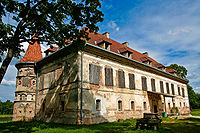 |
|
Poland
| Place | Building | Main period of construction | Special features | Image |
| Brochów Brochów, Masovian Voivodeship Brochów is a village in Sochaczew County, Masovian Voivodeship, east-central Poland. It is the seat of Gmina Brochów and lies some north of Sochaczew and west of Warsaw.... |
Fortified church | 1551–1561, 1596 | Gothic-renaissance Renaissance The Renaissance was a cultural movement that spanned roughly the 14th to the 17th century, beginning in Italy in the Late Middle Ages and later spreading to the rest of Europe. The term is also used more loosely to refer to the historical era, but since the changes of the Renaissance were not... church established by Jan Brochowski and his family as a three-nave Nave In Romanesque and Gothic Christian abbey, cathedral basilica and church architecture, the nave is the central approach to the high altar, the main body of the church. "Nave" was probably suggested by the keel shape of its vaulting... church with three side towers |
|
| Bydgoszcz | Church of the Assumption of Mary | 1582–1645 | ||
| Gdańsk Gdansk Gdańsk is a Polish city on the Baltic coast, at the centre of the country's fourth-largest metropolitan area.The city lies on the southern edge of Gdańsk Bay , in a conurbation with the city of Gdynia, spa town of Sopot, and suburban communities, which together form a metropolitan area called the... |
Green Gate Green Gate The Green Gate in Gdańsk, Poland, is one of the most notable tourist attractions of the city. It is situated between Long Market and the River Motława.-History:... |
1564–1568 | Example of the Flemish mannerism Mannerism Mannerism is a period of European art that emerged from the later years of the Italian High Renaissance around 1520. It lasted until about 1580 in Italy, when a more Baroque style began to replace it, but Northern Mannerism continued into the early 17th century throughout much of Europe... in the city inspired by the Antwerp City Hall Antwerp City Hall The City Hall of Antwerp, Belgium, stands on the western side of Antwerp's Grote Markt . Erected between 1561 and 1565 to the design of Cornelis Floris de Vriendt and several other architects and artists, this Renaissance building incorporates both Flemish and Italian influences.The low arcaded... (architect Regnier van Amsterdam) |
|
| Old Arsenal | 1602–1605 | Built in Dutch/Flemish mannerism by Anthonis van Obbergen Anthonis van Obbergen Anthonis van Obbergen was a Flemish architect and fortifications engineer... , Jan Strakowski and Abraham van den Blocke Abraham van den Blocke Abraham van den Blocke was an architect and sculptor.Van den Blocke was born in Königsberg , presumably the oldest of seven children of Dorothea and Willem van den Blocke. In 1584 the family lived in Gdańsk, Polish-Lithuanian Commonwealth, where he was educated as a sculptor in his father's workshop... |
 |
|
| Gołąb | Church of St. Catherine and St. Florian | 1628–1638 | Polish mannerism style | |
| Grocholin Grocholin Grocholin is a village in the administrative district of Gmina Kcynia, within Nakło County, Kuyavian-Pomeranian Voivodeship, in north-central Poland. It lies approximately west of Kcynia, south-west of Nakło nad Notecią, and west of Bydgoszcz.... |
Fortified manor house | 16th century | Built for Wojciech Baranowski, is a rear example of defense housing architecture in northern Poland | |
| Piotrków Trybunalski Piotrków Trybunalski Piotrków Trybunalski is a city in central Poland with 80,738 inhabitants . It is situated in the Łódź Voivodeship , and previously was the capital of Piotrków Voivodeship... |
Royal Castle | 1512–1519 | Gothic-renaissance | .jpg) |
| Płock | Płock Cathedral Dome Dome A dome is a structural element of architecture that resembles the hollow upper half of a sphere. Dome structures made of various materials have a long architectural lineage extending into prehistory.... |
1531–1534 | Romanesque cathedral, rebuilt several times | |
| Pułtusk | Collegiate Church Pułtusk vault | 1551–1556 | Renaissance frescoes on the vault cover more than 1000 square meters in total (brick church built between 1449 and the first half of the 16th century) | |
| Sandomierz Sandomierz Sandomierz is a city in south-eastern Poland with 25,714 inhabitants . Situated in the Świętokrzyskie Voivodeship , previously in Tarnobrzeg Voivodeship . It is the capital of Sandomierz County . Sandomierz is known for its Old Town, a major tourist attraction... |
Town Hall | 14th century | Rebuilt in the renaissance style in the 16th century | |
| Supraśl Suprasl Supraśl is a town in north-eastern Poland. It is the home of the Supraśl Lavra, one of only six Eastern Orthodox monasteries for males in Poland. Situated in the Podlaskie Voivodeship , previously in Białystok Voivodeship . It is located in Białystok County, about 15 km northeast of... |
Orthodox Monastery Suprasl Orthodox Monastery The Monastery of the Annunciation in Supraśl , also known as the Supraśl Lavra is a monastery in North Eastern Poland in the Podlaskie Voivodeship... - Church of the Annunciation |
1503–1511 | Gothic-renaissance Renaissance The Renaissance was a cultural movement that spanned roughly the 14th to the 17th century, beginning in Italy in the Late Middle Ages and later spreading to the rest of Europe. The term is also used more loosely to refer to the historical era, but since the changes of the Renaissance were not... , destroyed in 1944 by retreating German army, rebuilt since 1985 |
 |
| Tarnów Tarnów Tarnów is a city in southeastern Poland with 115,341 inhabitants as of June 2009. The city has been situated in the Lesser Poland Voivodeship since 1999, but from 1975 to 1998 it was the capital of the Tarnów Voivodeship. It is a major rail junction, located on the strategic east-west connection... |
Mikołajowski House | 15th century | Rebuilt in the renaissance style in 1524 | |
| Town Hall | 14th century | Rebuilt in the renaissance style in the 16th century | ||
| Zamość Zamosc Zamość ukr. Замостя is a town in southeastern Poland with 66,633 inhabitants , situated in the south-western part of Lublin Voivodeship , about from Lublin, from Warsaw and from the border with Ukraine... |
Zamość Fortress Zamosc Fortress Zamość Fortress is a set of fortifications constructed together with the city of Zamość . It was built between 1579 and 1618, and the construction was initiated by Chancellor and Hetman Jan Zamoyski... |
1579–1618 | 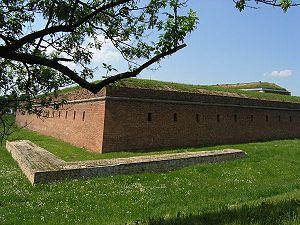 |
|
Sweden
| Place | Building | Main period of construction | Special features | Image |
| Kristianstad Kristianstad Kristianstad is a city and the seat of Kristianstad Municipality, Skåne County, Sweden with 35,711 inhabitants in 2010.-History:The city was founded in 1614 by King Christian IV of Denmark, the city's name literally means 'Town of Christian', as a planned city after the burning of the town of Vä... |
Holy Trinity Church Trinity Church, Kristianstad Trinity Church is a religious building in Kristianstad, Sweden, built between 1617 and 1628 by Christian IV of Denmark. He had founded the city of Kristianstad in 1614 at a time when Scania was part of the Kingdom of Denmark... (Swedish Swedish language Swedish is a North Germanic language, spoken by approximately 10 million people, predominantly in Sweden and parts of Finland, especially along its coast and on the Åland islands. It is largely mutually intelligible with Norwegian and Danish... : Helga Trefaldighetskyrkan) |
1617-1628 | The city of Kristianstad was founded by king Christian IV of Denmark Christian IV of Denmark Christian IV was the king of Denmark-Norway from 1588 until his death. With a reign of more than 59 years, he is the longest-reigning monarch of Denmark, and he is frequently remembered as one of the most popular, ambitious and proactive Danish kings, having initiated many reforms and projects... in 1614 at a time when Scania Scania Scania is the southernmost of the 25 traditional non-administrative provinces of Sweden, constituting a peninsula on the southern tip of the Scandinavian peninsula, and some adjacent islands. The modern administrative subdivision Skåne County is almost, but not totally, congruent with the... was part of the Kingdom of Denmark (until 1658). |
|
| Mariefred Mariefred Mariefred is a locality situated in Strängnäs Municipality, Södermanland County, Sweden with 3,813 inhabitants in 2005.The name is derived from that of the former Carthusian monastery here, Mariefred Charterhouse, and means "Peace of Mary"... |
Gripsholm Castle Gripsholm Castle Gripsholm Castle is a castle in Mariefred, Södermanland, in Sweden and is regarded as one of Sweden's finest historical monuments. It is located by lake Mälaren in south central Sweden, in the municipality of Strängnäs, about 60 km west of Stockholm.... |
1537- | Built on the site of a medieval castle, which is partly preserved in the current castle. | |
| Stockholm Stockholm Stockholm is the capital and the largest city of Sweden and constitutes the most populated urban area in Scandinavia. Stockholm is the most populous city in Sweden, with a population of 851,155 in the municipality , 1.37 million in the urban area , and around 2.1 million in the metropolitan area... |
Swedish House of Nobility (Swedish: Riddarhuset) | 1641-1675 | The building is more or less unchanged since its construction. | |
| Trolle Ljungby | Trolle Ljungby Castle Trolle-Ljungby Castle Trolle-Ljungby Castle is a castle in Kristianstad Municipality, Scania, in southern Sweden. The castle is enclosed by a moat and it is one of most magnificent Renaissance buildings in Sweden.-References:... |
1620s-1630s | The castle was mainly constructed when Scania was part of the Kingdom of Denmark Denmark Denmark is a Scandinavian country in Northern Europe. The countries of Denmark and Greenland, as well as the Faroe Islands, constitute the Kingdom of Denmark . It is the southernmost of the Nordic countries, southwest of Sweden and south of Norway, and bordered to the south by Germany. Denmark... (until 1658). |
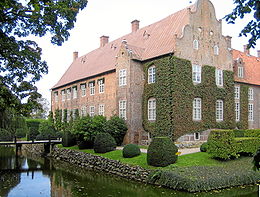 |

